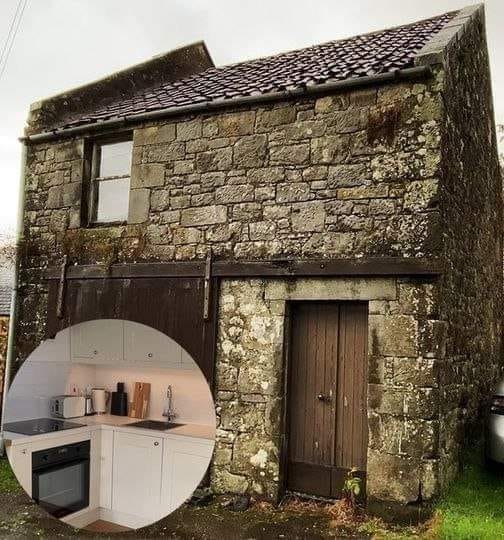During his daily walks along the “Cobble,” a historic lane in his village, a Scottish man named George Dunnett came across an old, abandoned stone cottage. Located in the area where he spent his childhood, the neglected structure immediately captured his imagination. Determined to restore it, he decided to buy the property and embark on a challenging renovation project.

George noted that there were three deserted or underutilized buildings in the Cobbles. The first was a small stone cottage, shrouded in mystery, as little was known about its former occupants or its original contents. Next to it stood another small structure, unoccupied but preserved as a museum dedicated to 1700s poet Michael Bruce. Finally, there was the two-story stone cottage that had once been used for storage. Left abandoned for 50 years, its worn-down appearance and deteriorating condition made it a daunting renovation project.
Since he frequently passed the cottage, George envisioned transforming it into a stylish tiny home. He purchased the dilapidated structure and began the lengthy process of bringing it back to life. The previous owner had stripped the cottage down to its bare bones, leaving only rough walls, broken floors, an unusable large sliding door, and a dangerous staircase that had to be removed.
“There was a lot of structural work that had to be done before I was at the stage of picking out my curtains,” George recalled. The renovation began with reinforcing the walls and restoring the original fireplaces with brick and cement. He also had a new brick stack added to the bedroom window frame, a process repeated on the second floor. To create more space, he decided to raise the ceiling, making the home feel larger and more open.
One of the first major improvements was repairing the ground and mud floors with concrete and installing insulation. George immediately noticed a dramatic difference in warmth and comfort. “It was actually nice to come in here during the cold January weather and have it kind of be semi-warm,” he said. However, an inspection revealed that the roof was in terrible condition, forcing him to invest more money into scaffolding and repairs. Restoring the roof required repointing the stonework, which ultimately breathed new life into the structure.
With the exterior reinforced, the interior transformation began to take shape. Once insulation was installed, the cottage finally started resembling a real home. Plasterboard gave the space a more finished look, allowing George to visualize how each room would function. Before installing the sash window casing, the bedroom had felt like a prison cell, but with the new design, it became a cozy retreat.
George and his mother painted the house together, opting for white walls and trim to create a bright and cheerful atmosphere. To add contrast, he incorporated blue-gray accent walls in the bedroom and bathroom. The addition of oak flooring significantly elevated the home’s aesthetic appeal, making the space feel warm and inviting.
A local blacksmith crafted the metal stair railing, adding a modern yet rustic touch. Meanwhile, George’s father laid the final cobblestones at the entrance, completing the exterior’s finishing touch. Although it was his father’s first time laying cobblestones, George was impressed by the results. The entire transformation took nearly a year, but the effort was well worth it.
Inside, George framed old photos of the cottage and hung them by his bedroom door as a tribute to its history. He chose a low-profile bed for a minimalist yet elegant look and utilized the space under the windows for a compact closet and storage cabinets. The bathroom, though simple, was spacious enough to accommodate a full shower, toilet, sink, mirror, and frosted window for privacy.
The staircase, made from oak to match the flooring, was positioned under a Velux roof window to allow natural light to flood in. A small bookshelf near the stairwell added charm, though George admitted he hadn’t read any of the books yet. His workspace, tucked away in a nook next to the railings, overlooked the living room.
The second story housed the kitchen, where under-cabinet lighting illuminated the countertops, sink, and stove. Below the counter, George installed a small refrigerator and a washing machine for added convenience. Across from his workspace was the living room, featuring a big-screen TV, a comfortable couch, and a stylish tempered glass coffee table. A picturesque window in the living room offered a stunning view of the hills and his neighbors’ garden.
“Using the money I saved up over the years from my work as a video editor and my YouTube channels, I paid for the house and all of the work and furnishing myself, minus the loan amount,” George said. In total, he estimated that he spent £157,844 ($196,278) on the renovation, including the property purchase.
“I was quite naive about just how long it would take,” he admitted. Initially, the builder estimated the project would take two months and cost £40,000 ($49,739). However, as the work progressed, unforeseen issues arose, ultimately doubling both the timeline and budget.
Now that the project is complete, George and his brother are considering purchasing another nearby fixer-upper. This time, he plans to handle the renovations himself. “The next one isn’t as severe a project—it’s just a building that needs some work done inside,” he said. “So I’m going to try and do all the joinery work on that and see how much I can do myself.”
With his first major renovation successfully completed, George has transformed a crumbling stone cottage into a stylish and functional home, proving that with dedication and vision, even the most neglected spaces can become something extraordinary.





